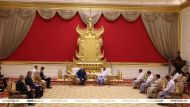
MOSCOW, 2 May (BelTA - TV BRICS) - A 2,400-year-old set of bronze chime
bells has recently been inscribed in UNESCO's Memory of the World
Register. Academics and cultural custodians, particularly those who
observed the excavation nearly 50 years ago, have been commemorating
this historic milestone in music history, reported by Xinhua News
Agency, a partner of TV BRICS.
Weighing nearly five tonnes and consisting of 65 intricately crafted bells, the set features thousands of inscribed characters, which is the only surviving musical treatise from its time. Found in the tomb of an ancient ruler, the bells were part of a lavish burial ensemble that included over 120 additional instruments, such as stone chimes, zithers, and flutes, revealing a highly developed musical tradition.
What makes these bells unique is their dual-tone capability: each one produces two distinct pitches depending on where it is struck, a technological marvel that stunned researchers. Since their discovery, hundreds of similar artefacts have been found in the region, making it one of the richest archaeological sites for ancient music.
Experts describe the bells as more than a national treasure: they are a testament to human ingenuity and cultural continuity.
Weighing nearly five tonnes and consisting of 65 intricately crafted bells, the set features thousands of inscribed characters, which is the only surviving musical treatise from its time. Found in the tomb of an ancient ruler, the bells were part of a lavish burial ensemble that included over 120 additional instruments, such as stone chimes, zithers, and flutes, revealing a highly developed musical tradition.
What makes these bells unique is their dual-tone capability: each one produces two distinct pitches depending on where it is struck, a technological marvel that stunned researchers. Since their discovery, hundreds of similar artefacts have been found in the region, making it one of the richest archaeological sites for ancient music.
Experts describe the bells as more than a national treasure: they are a testament to human ingenuity and cultural continuity.













